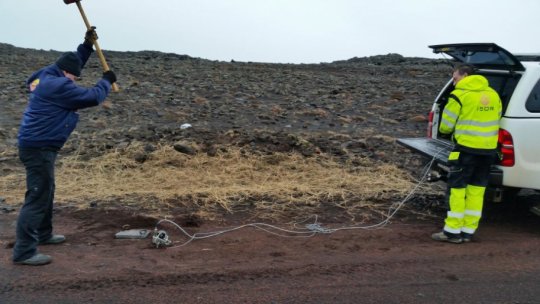[ad_1]
Fibre-optic cables can be used to detect earthquakes and other ground movements. The data cables can also pick up seismic signals from hammer shots, passing cars or wave movements in the ocean. This is the result of a study appearing in the journal Nature Communications on July 3 2018. The main authors are Philippe Jousset and Thomas Reinsch from GFZ German Research Centre for Geosciences. They carried out the investigation together with colleagues from Island, UK, Berlin, Germany, and Potsdam, Germany.
The scientists sent pulses of laser light through an optical fibre, which was part of a 15 kilometer long cable deployed in 1994, within the telecommunication network on Reykjanes peninsula, SW Island, crossing a well-known geological fault zone in the rift between Eurasian and American tectonic plates. The light signal was analyzed and compared to data sets from a dense network of seismographs. The results amazed even experts: “Our measurements revealed structural features in the underground with unprecedented resolution and yielded signals equaling data points every four meters,” says Philippe Jousset from the GFZ. He adds: “This is denser than any seismological network worldwide.” After presenting preliminary ideas at several conferences since 2016 Philippe was told that the new method was a ‘game changer for seismology’. Although the method is not new in other applications (it is used for years in boreholes for reservoir monitoring), the team is the first worldwide that carried out such measurements along the surface of the ground for seismological objectives, and with such a long cable.
Their current study not only shows well-known faults and volcanic dykes. The scientists also found a previously unknown fault, below the ground surface. Furthermore, the team measured subsurface deformation taking place over a period of several minutes. Small local earthquakes, waves originating from large distant quakes, and microseism of the ocean floor were also recorded via fibre-optic cable. “We only need one strand of a modern fibre-optic line,” says Charlotte Krawczyk, Director of GFZ’s Geophysics Department.
The advantages of the new method are enormous as there are countless fibre-optic cables spanning the globe in the dense telecommunication network. Especially beneath megacities with high seismic hazards, such as San Francisco, Mexico City, Tokyo, or Istanbul, and many others, such cables could provide a cost efficient and widely spread addition to existing seismological measuring devices.
Future studies are planned to investigate whether deep-sea cables can also be used for seismic measurements. The scientists are optimistic. They think that the cables on the sea floor will detect submarine earthquakes, ground motions of tectonic plates, and also variations of the water pressure. Thus, the new method will help seismologists as well as oceanographers.
Story Source:
Materials provided by GFZ GeoForschungsZentrum Potsdam, Helmholtz Centre. Note: Content may be edited for style and length.
[ad_2]















